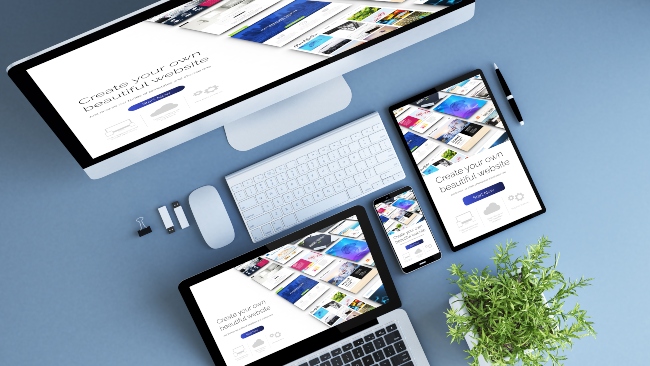Creating Drag and Drop Websites Using Website Builders
Using a website builder is the easiest way to dive into launching a new website. Although there’s a bit more to it than just ‘drag and drop’ and...
5 min read
![]() StoryTeller Team
:
Apr 5, 2022 7:45:00 AM
StoryTeller Team
:
Apr 5, 2022 7:45:00 AM
![What Makes a Good Website? [Q&A With a Web Designer]](https://www.storytellermn.com/hubfs/2021-clean/images/blog/WhatMakesAGoodWebsite-STMC.jpg)
It’s not an overstatement that in our digital age, your website is one of your business’s most powerful tools. One of the first things to understand about a “good” website design is that your website needs so much more than just an aesthetically pleasing look. In fact, your website can – and should – be the cornerstone of your sales and marketing strategy. A “pretty” website isn’t built to move leads through the sales pipeline, and a layout that doesn’t meet your customers' needs will require much more of an overhaul than just new font and updated colors.
We spoke to StoryTeller’s very own, in-house web designer, developer, and all-around web guru, Melissa Nault, about the key tenets she keeps in mind when building client websites that are optimized for search, marketing, sales, AND look aesthetically beautiful.
First of all, websites must be built with SEO in mind if you want to increase traffic and generate leads online. Important keywords should be included throughout web page headers, copy, and even within images’ meta descriptions throughout your website. Google algorithms crawl web pages to try to find the best matches for what your prospects are searching for, so make it as easy as possible for Google to match you to the right visitors!
Once prospects find your page, a visually pleasing design will encourage them to stay longer, which decreases bounce rates and increases average time on page, credibility, clicks, and conversion opportunities. It’s important to optimize images and videos with alt-text and by resizing them to decrease page speed. All of these factors will help your website rank higher. That’s why website design is more than just “putting lipstick on a pig”– it needs to be highly functional for the user and optimized for search.
A good website should be clean and minimalistic to avoid overwhelming your viewers. As the old advertising saying goes, “keep it simple, stupid.” Not only should it be easy to navigate, but users should enjoy browsing your site. Be sure to make your website navigation an experience with dynamic visuals–such as video–and encourage exploration with different call-to-actions (CTAs) for the visitor to take the next step down the funnel. Your navigation should be well thought out and intuitive for your audience. There’s no ‘one size fits all’ for order of headers; instead, you should cater to your visitors' wants and needs.
To improve navigation and user experience (UX), add some navigation or links to the footer and include a search bar so visitors can search by keyword. Include a captivating headline or subhead and a statement “above the fold” to reassure the visitor that you can help them solve their problem. And for the readers who have a little harder time seeing little words on a little screen, make sure all text is large enough–and clear enough–to read.
The design should always be consistent with the brand and brand colors. Your color pallet should include a highlight color that really ‘pops’ to use for buttons and CTAs. Select one graphic element at the beginning of the design to use consistently across all pages, and never use more than two font faces! Play around with what two look best together.
Good websites will often include testimonials from their customers or companies they have worked with in the past to establish trust and authority. And after building each page, make sure links are working properly and proof it in responsive/mobile view to confirm it looks as good as it does on desktop.
Most importantly, you’ll want a well-thought-out home page, services page, an about page, and a contact us page. Of course, this varies across industries. Although there’s no magic number for the number of pages a website should have, remember that if your goal is to drive traffic to your site and rank higher on Google, you’ll perform better the more quality content you have. That’s one reason blogging continues to play such an important role online. According to research from the Content Marketing Institute, businesses with blogs generate over 400% more search-indexed pages on their websites.
The role of content is another reason why it’s important to start building your website with the end goal in mind, and why we always recommend companies to include a blog as part of their ongoing marketing efforts. Plus, blogging is a great way to offer helpful information to your target audience in order to build trust and share your expertise. In all of your website design and strategy planning, remember to put yourself in the shoes of your users and consider what would make the best experience for them.
I usually Google the industry I am designing for and look at websites that are high ranking, as well as spend time looking through HubSpot’s Solutions Directory for new ideas. I also consistently go to the website for the developer of the theme we are using, Helpful Hero. Kevin Froman showcases “Real-World Examples” of sites, which usually gives me a lot of inspiration for my next design.
As mentioned earlier, it’s critical to understand the client’s unique goals for their new website before building a new one. Every business is different, and in order to build a website that fits their needs, we need to understand what their target audience wants and what kind of messaging will resonate with them.
We always begin our process by conducting a website audit of a client’s existing website, and note what is and is not working, their branding, and so on. I also provide the client with a Design Survey that I request they complete. It asks specific questions about the style they like, don’t like, colors, graphics, mood, etc. It also includes a list of websites that I ask them to “Like” or “Dislike.” Combined with their brand, I am usually able to start designing a framework to show the client.
Video moves people like no other online channel, but only a strong video production and video marketing strategy gets them to act. It’s a great way to tell a story about your brand and to showcase products and services. As mentioned, video can keep your users engaged on your site for longer, which can help optimize your page for search. It’s no secret that video is king.
Video can sometimes slow down a webpage, so it often makes sense to host videos on a video player and then embed them on your site. Also, you should utilize your video content as much can, but avoid redundancy. So, add video where it’s relevant and helpful but don’t overcrowd your site with video or use the same video on too many pages. Give people the option to either read what you’re trying to communicate or watch a video on it.
Think about your website as an evolving tool, built to grow. Start with a clearly defined goal for the visitors of your website, such as, “finding new members for your private club”, and view everything else – the design and content – through that lens. Have you answered your prospects' key questions? Have you made it easy for them to find information on membership? Do your images showcase how much fun a new member would have? This is how a website becomes a sales and marketing tool.
Also, remember “perfect” is the enemy of “good.” As long as it’s built with a strong, strategic foundation and quality design, your website doesn’t have to be complete and perfect before you launch. (For example, you don’t need to launch with 1,000 web pages, you can start with the top 20 most important and keep adding more after you launch, in phases.) This concept is called “growth-driven design”, and it’s a core belief at our agency because a site is never really done. Instead, it’s the beginning of a much more strategic, well-designed future.

Using a website builder is the easiest way to dive into launching a new website. Although there’s a bit more to it than just ‘drag and drop’ and...

Launching a new website requires significant amounts of research and planning, not to mention major investments of time, energy, and resources to see...

For many organizations, the fourth quarter is a time for budgeting and planning for next year. If you are responsible for creating the marketing...